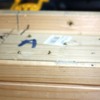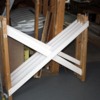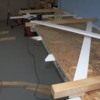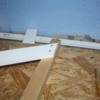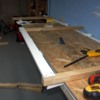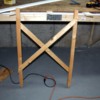I finished laying out all of the girders on the floor, and went back to the computer to determine some reference points as the erection process begins. I measured from the back walls to the extremes of the front girder and marked that distance on the floor. I also measured off where the leg sets would go (5 of them) at 8 ft. intervals. Eight feet seems like a reasonable span for the girders. When all braced up, there's no downward deflection at that spacing.
The front main girder set has a girder face to girder face distance of 40". My old legs sets are somewhere about 24" apart, so they needed to be reconstructed to work in the new design. Here's the "before" girder picture. I wanted to use the old legs since they already have the elevating screws and t-nuts installed on their bottoms so why reinvent them.
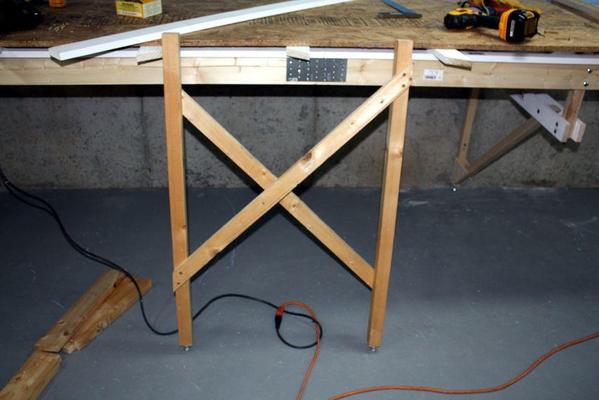
I removed the X-bracing, saving the 5-50 Spax metric screws (these go back to when the layout was originally constructed in Germany), and the lumber which will be put to good use making joists that lie across the girders. I then cut a 48" piece of 1 X 3 that served as a spacing beam. The legs were made of German metric-sized lumber. Their 2 X 2 is 44mm square, and is more substantial than our 1.5" dimensional lumber (38.1mm). I fasten one screw on one corner of the spacing beam, and square that corner up. When square I drive another screw to lock the geometry. I again used #8 X 2" Deck Mate screws with star drive. I can remove them and re-drive them over and over without destroying the star drive socket. When the first side is tight and square I did the same with the other leg.
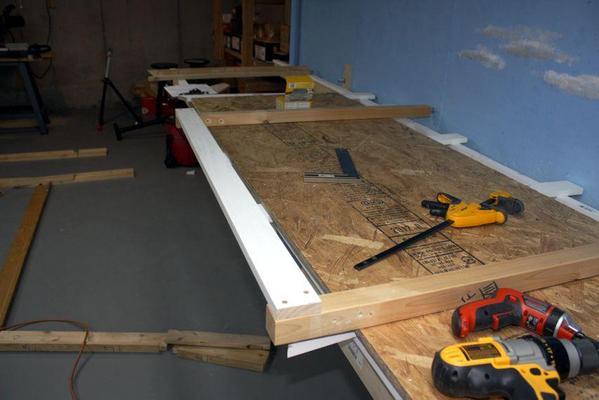
When I first starting doing this task, I was doing it on the concrete floor with my rubber knee pads. My back was letting me know that this was not the best approach, so I got a piece of OSB, threw it on the back installed girders over a few 1 X 3s and did the work standing up. Much better!
I cut the X-braces from fresh 1 X 3s since they're pretty long. There is no worry about losing square since the two screws on the spacing beam were tight so it was just the repetitive task of lining up the X-brace, clamping the near end so I could position the far end, screw far end tight and go back to the near end, put it one screw, remove the clamp and then put in the other screw. Turn the entire assembly over and put on the opposite X-brace the same way. The ends are beveled and I'm careful to not let it extend past the leg as shown here. The reason for this is to not foul the gusset plate that's going to be installed at the bottom for the longitudinal braces, and to not interfere with installing the girders on the top of the legs.
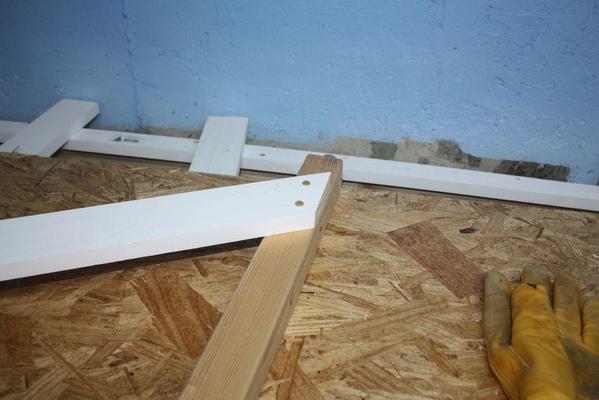
Here's the two braces installed.
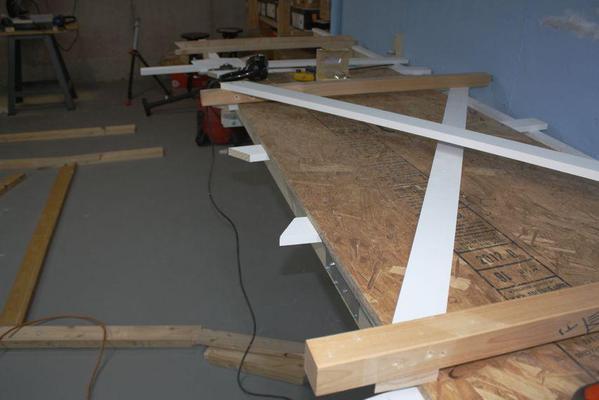
Once the X-braces are in place the spacing beam is removed since the legs can no longer change geometry. I used the spacing beam for the next set of legs ensuring that all the leg sets for this part of the layout would have the same spacing. All five sets took a couple of hours to reconstruct. Here's four of the completed legs.

When I finished the legs sets I turned my attention back to the girders. I used the wooden splice blocks from the old RR to tie together the separate pieces of girders making up the system. I re-used the 5X50mm screws on these plates, but they are a tad long leaving a nasty sharp point sticking out the back side. I don't like sharp pointy things sticking out of the wood so I again brought the Dremel out with its cut-off wheel and ground them flush with the surrounding wood. Here are those sharp points.
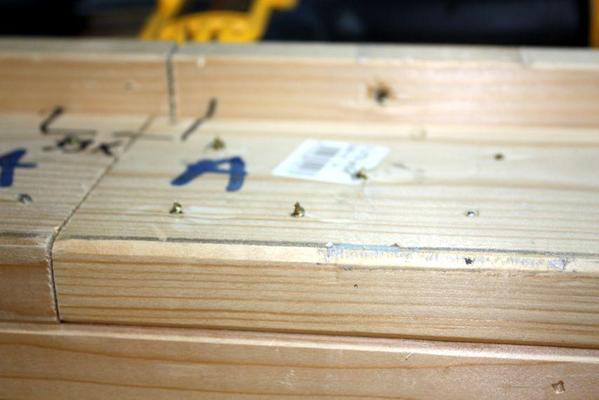
With the legs for the front part of the layout complete, I started messing around with setting it up. Using clamps you can actually put this together with one person. You lift a girder and clamp it to one side of the leg. While keeping the leg from collapsing, grab the other girder and clamp it to the other side. Go to the other end, and do the same thing with the second leg set. If all goes well so far, you have a very rickety structure that's just barely hanging together. From that point, you have to set the girder height and then temporarily clamp a longitudinal diagonal brace to start squaring it up. I was all set to make new diagonals and then I remembered that all the previous diagonals were sitting in the other part of the basement with the gusset plates still attached. I was careful when taking this apart for the move so much can be re-installed.
It was getting late and I was getting worn out. I was attempting to run a level from the newly installed rear girder to these old girders to set their height. My foot bumped one of the legs and the whole shebang came crashing down. That was a sign! Quite while you're ahead and I stopped work for the day and went up for dinner. Next time, I'll use the big C-clamps since they have more grip than the quick clamps I was using.
This part of the work goes very fast. It will slow down again when I start installing all those joists and their risers.




